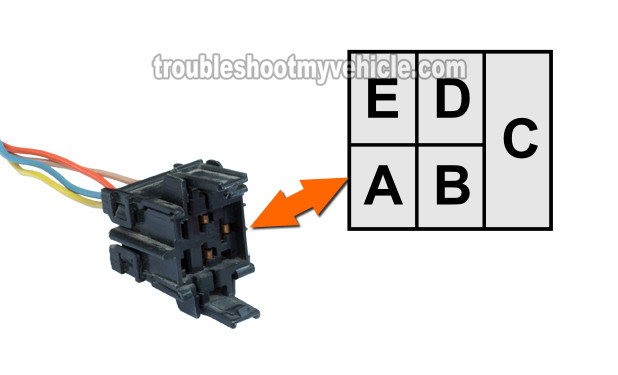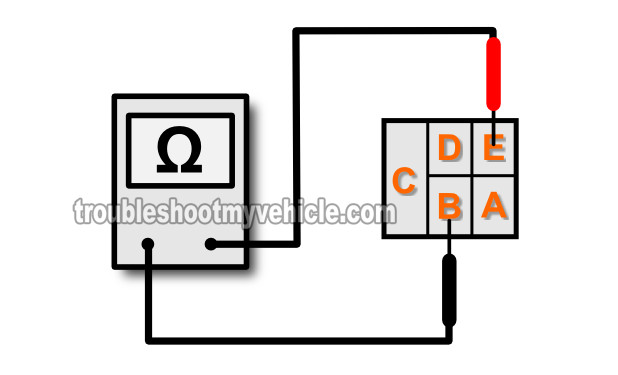
This tutorial will help you test the blower switch on 1991 to 1994 Chevy Cavalier.
The blower switch can be tested with a multimeter and I'll show you how in a step-by-step way.
Contents of this tutorial:
This tutorial compliments this one on testing the blower motor resistor:
Basics Of Troubleshooting The Blower Control Switch
In a nutshell, the blower switch interrupts and diverts the electrical current from one contact to another.
What this means in plain English is that as you turn the blower fan speed knob (LO, M1, M2, and HI), the blower switch mechanically opens and closes the two contacts necessary to divert the incoming battery power (from circuit E) to the different circuits that'll get the blower fan speed you're choosing.
To really explain this and make it make more sense, let me give you an example of what happens when you turn the blower fan speed knob from OFF to LO:
- When the blower fan is in the LO position:
- Battery power is available in terminal E of the blower switch connector.
- This battery power is channeled nowhere in this position.
- When you turn the blower fan switch to the M1 position:
- Battery power is available in terminal E of the blower switch connector.
- The blower switch now bridges (closes) the contacts for terminal E and C (internally).
- The blower motor now runs in M1 speed.
- When you turn the blower fan switch to the M2 position:
- Battery power is available in terminal E of the blower switch connector.
- The blower switch now opens the contacts for terminal E and C.
- The blower switch now bridges (closes) the contacts for terminal E and D (internally).
- The blower motor now runs in M2 speed.
- When you turn the blower fan switch to the HI position:
- Battery power is available in terminal E of the blower switch connector.
- The blower switch now opens the contacts for terminal E and C.
- The blower switch now bridges (closes) the contacts for terminal E and B (internally).
- The blower motor now runs in HI speed.
Since these are mechanical connections the blower switch is making to open and close these circuits, over time and use these contacts become pitted and covered in carbon (from the electrical arching that occurs when the contacts close). When this happens, one or several of the blower fan speeds stop working.
The cool thing is that diagnosing/troubleshooting the blower switch isn't hard. The following circuit descriptions will help:
| Blower Switch Circuit Descriptions | ||
|---|---|---|
| Pin | Wire Color | Description |
| A | -- | Empty. |
| B | ORG | HI Speed Output. |
| C | TAN | M1 Speed Output. |
| D | LT BLU | M2 Speed Output. |
| E | YEL | Power Input From Vent Position Switch. |
TEST 1: Multimeter Continuity Tests
Checking the continuity of the different blower speed switch positions isn't hard (the hard part is getting to the switch since you have to remove the A/C Heater control panel).
Below you'll find the two pins you'll need to test. The illustrations in the image viewer will help you to identify your Chevy Cavalier's blower switch pins.
IMPORTANT: All multimeter continuity tests described in this test section are done on the blower switch's male spade metal terminals and not on the switch's connector. All the illustrations (in the image viewer) are of the blower switch itself and NOT of the connector (see image 4 of 4).
OK, these are the test steps:
- 1
Remove the A/C-Heater control panel from the dash and set your multimeter to Ohms mode (Ω).
Don't have a multimeter or need to upgrade yours? Check out my recommendation: Buying A Digital Multimeter For Automotive Diagnostic Testing (found at: easyautodiagnostics.com). - 2
With the blower switch knob set to the M1 position.
You should have continuity between C and E (see image 1 of 4 to identify the proper male spade terminals to probe). - 3
With the blower switch knob set to the M2 position.
You should have continuity between D and E (see image 2 of 4 to identify the proper male spade terminals to probe). - 4
With the blower switch knob set to the HI position.
You should have continuity between B and E (see image 3 of 4 to identify the proper male spade terminals to probe).
Let's take a look at what your test results mean:
CASE 1: One or more of the circuits tested DID NOT have continuity when the blower fan speed knob was turned. Repeat the tests just to make sure of your test results.
If continuity is not present where indicated in the test steps above and this lack of continuity coincides with the blower fan speed that's not working on your pickup or SUV, then you've found the cause of the problem.
Replace the blower switch in the A/C-Heater control panel with a new one to solve the problem. To comparison shop for the blower control switch, take a look at this section here: Where To Buy The Blower Switch And Save.
CASE 2: All circuits tested had continuity where indicated in the test steps. This is good and is the correct and expected test result that tells you that the blower fan switch (in the A/C-Heater control panel) is OK.
Your next step is to bypass the blower resistor using a simple jumper wire. For this test go to: TEST 2: Using A Jumper Wire To Bypass The Blower Switch.






